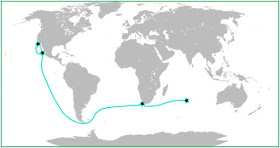*More than 31,000 page views in the USA, 14,000 in Russia, 9,000 in Singapore and 6,000 in France.
Do it safe (L5U3)
 |
| Jet skiing is a water sport. |
 |
| Two snow sports. |
 |
| Snow sport. |
They are sledging. They're wearing hats, gloves and boots but they aren't wearing sunglasses or goggles! They should be careful.
Around the world (L5U3)
 |
| "Abby Sunderland" |
Abigail Jillian "Abby"
Sunderland (born October 19, 1993) is an American sailor
who, in 2010, attempted to become the youngest person to sail solo around the
world, but failed.
In June 2010, 16-year-old Abby Sunderland
attempted to break the record for being the youngest person ever to complete a
solo sail around the world. But when she found herself stranded at sea after a
storm damaged her boat, Abby's life was saved by a NASA-developed Personal
Locator Beacon (PLB), which transmitted a distress signal to a Search and
Rescue (SARSAT) satellite, 22,500 miles away in space. On October 25, 2010,
Abby visited NASA's Goddard Space Flight Center to meet the team that developed
this Search and Rescue technology more than 30 years ago.
 |
| "Abby Sunderland's route map" |
Sunderland was the subject of a documentary
film produced and directed by her father titled Wild Eyes: The Abby
Sunderland Story. The film was released on September 8, 2011
Sunderland released a book about her ordeal
on April 12, 2011. The book is co-written with Lynn Vincent and is titled Unsinkable:
A Young Woman's Courageous Battle on the High Seas. She has been going on
book-signing tours, where it was revealed that she is taking flying lessons, to
be able to fly around the world.
37ºC (L5U3)
Normal human body
temperature, also
known as normothermia or euthermia, depends upon the place in the
body at which the measurement is made, the time of day, as well as the activity
level of the person. Despite what many schoolchildren are taught, there is no
single number that represents an ideal temperature for all people, under all
circumstances, at any time of day, and using any place of measurement. Instead,
the body temperature of a healthy person changes slowly but constantly during
the course of the day.
 |
| Commonly accepted average body temperature. |
Different parts of the body
have different temperatures. The commonly accepted average core body
temperature (taken internally) is 37.0 °C. The
typical oral (under the tongue) measurement is slightly cooler, at 36.8°, and
temperatures taken in other places (such as under the arm or in the ear)
produce different typical numbers. Although some people think of these averages
as representing the normal or ideal temperature, a wide range of temperatures
has been found in healthy people.
St George (L6U3)
The episode of St. George and the Dragon
was a legend brought back with the Crusaders and retold with the courtly
appurtenances belonging to the genre of Romance. The earliest known depiction
of the legend is from early 11th-century Cappadocia (in the iconography of the
Eastern Orthodox Church, George had been depicted as a soldier since at least
the seventh century); the earliest known surviving narrative text is an
11th-century Georgian text.
Saint George is somewhat of an exception
among saints and legends, in that he is known and revered by Muslims, while
being venerated by Christians throughout the Middle East, from Egypt to Asia
Minor. His stature in these regions derives from the fact that his figure has
become somewhat of a composite character mixing elements from Biblical,
Quranic, and folkloric sources, at times being the partially contrapositive of Al-Khidr.
He is said to have killed a dragon near the sea in Beirut, for which a Saint
George Bay was built under his name. At the beginning of the 20th century, Arab
Christian women visited his shrine in the area to pray for him.
Pegasus (L6U3)
Pegasus is
one of the best known creatures in Greek mythology. He is a winged divine
stallion usually depicted as pure white in color. He was sired by Poseidon, in
his role as horse-god, and foaled by the Gorgon Medusa. He was the brother of Chrysaor,
born at a single birthing when his mother was decapitated by Perseus.
Greco-Roman poets write about his ascent to heaven after his birth and his
obeisance to Zeus, king of the gods, who instructed him to bring lightning and
thunder from Olympus. Friend of the Muses, Pegasus is the creator of Hippocrene,
the fountain on Mt. Helicon. He was captured by the Greek hero Bellerophon near
the fountain Peirene with the help of Athena and Poseidon. Pegasus allows the
hero to ride him to defeat a monster, the Chimera, before realizing many other
exploits. His rider, however, falls off his back trying to reach Mount Olympus.
Zeus transformed him into the constellation Pegasus and placed him up in the
sky.





